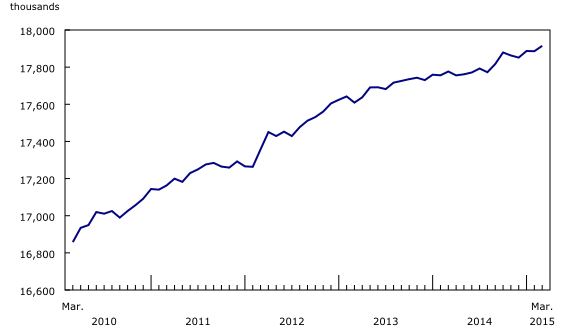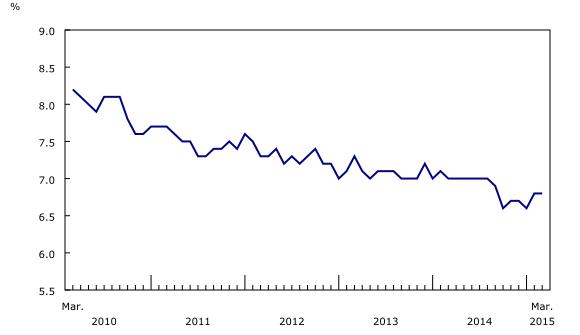Labour Force Survey, March 2015
Archived Content
Information identified as archived is provided for reference, research or recordkeeping purposes. It is not subject to the Government of Canada Web Standards and has not been altered or updated since it was archived. Please "contact us" to request a format other than those available.
Released: 2015-04-10
Employment increased by 29,000 in March, driven by gains in part-time work. The unemployment rate was unchanged at 6.8%.
Over the first quarter, employment gains totalled 63,000 (+0.4%), the result of more part-time work.
In the 12 months to March, employment increased by 138,000 (+0.8%), with most of the growth in full-time work. Over the same period, the total number of hours worked was little changed (+0.1%).
In March, employment rose in Saskatchewan and Manitoba, and was little changed in the other provinces.
There were more people working in retail and wholesale trade, transportation and warehousing, educational services and natural resources in March. At the same time, there were fewer people working in construction, public administration as well as agriculture.
The number of public sector workers increased in March. There was little change in the number of private sector employees and the self-employed.
In March, employment rose among women aged 55 and older, while there was little change among the other demographic groups.
Adjusted to concepts used in the United States, the unemployment rate in Canada was 5.9% in March, unchanged from February. At the same time, the US unemployment rate was 5.5%, also unchanged from a month earlier.
Provincial summary
Employment in Saskatchewan rose by 7,000 in March, the first notable increase since September. The unemployment rate fell 0.6 percentage points to 4.4% in March, the lowest among the provinces. Compared with 12 months earlier, employment in Saskatchewan increased by 6,700 (+1.2%).
In March, employment in Manitoba increased by 6,100, bringing year-over-year growth to 19,000 or 3.1%, the highest growth rate among the provinces.
Employment in Alberta was little changed in March, as gains in part-time work were offset by losses in full time. Despite no growth in the first quarter, employment in the province was up 1.9% (+44,000) on a year-over-year basis.
In March, employment was also little changed in both Quebec and Ontario. In Quebec, year-over-year growth was 0.8%, with all of the gains in the first two months of 2015. In Ontario, employment edged up 0.5% compared with 12 months earlier.
Industry perspective
There were 20,000 more people working in retail and wholesale trade in March, the first gain in this industry since October. However, employment in this industry was little changed compared with March 2014.
Employment in transportation and warehousing was up 16,000 in March. Employment in this industry was little changed compared with 12 months earlier, as losses in the first six months of the period were offset by gains in the second half.
Following two months of losses totalling 26,000, employment in natural resources increased by 6,300 in March. Over the past 12 months, employment in this industry was down 16,000 (-4.3%).
In March, there were 12,000 more people working in educational services. Compared with 12 months earlier, employment in this industry was up 69,000 or 5.7%, the largest year-over-year growth rate of all sectors.
Employment in construction was down 12,000 in March. Despite this loss, employment in this industry has been on an upward trend since May 2014.
There were 11,000 fewer people employed in public administration in March. Employment in the industry was little changed compared with 12 months earlier, as gains in the first six months of the period were followed by losses in the second half.
Agriculture employment declined by 6,100 in March, contributing to a year-over-year employment loss of 14,000 (-4.5%).
While there was little employment change in 'other services' in March, employment has been declining in this industry group since July 2014. Compared with 12 months earlier, there were 45,000 fewer people working in 'other services,' the largest decline of all industries. Most of the declines were in repair and maintenance, and private household services such as those provided by nannies and home support workers.
Employment up for women aged 55 and older
There were 18,000 more women aged 55 and older working in March and their unemployment rate was unchanged at 5.2%. Employment for men in the same age group was little changed, but their unemployment rate fell by 0.5 percentage points to 5.8% as fewer of them searched for work.
In the 12 months to March, most of the increase in total employment was among people aged 55 and older, up 96,000 or 2.8%.
Youth employment was virtually unchanged in March, as was the case for men and women aged 25 to 54.
Canada–United States comparison
Adjusted to US concepts, the unemployment rate in Canada was 5.9% in March, while the rate in the United States was 5.5%. Compared with March 2014, the unemployment rate in Canada edged down 0.2 percentage points, while the US rate fell by 1.1 percentage points.
In March, the employment rate in Canada (adjusted to US concepts) was 62.0%, compared with 59.3% in the United States. On a year-over-year basis, the employment rate edged down 0.1 percentage points in Canada, while it increased by 0.3 percentage points in the United States.
Quarterly update for the territories
The Labour Force Survey also collects labour market information about the territories. This information is produced monthly in the form of three-month moving averages. With this release, data for the territories are seasonally adjusted, allowing comparisons with consecutive time periods.
In the first quarter of 2015, employment in Yukon and the Northwest Territories was little changed compared with the fourth quarter of 2014, and their unemployment rates were 5.3% and 7.9%, respectively. Employment in Nunavut increased by 400 in the first quarter of 2015, and the unemployment rate fell from 12.9% to 12.0%. Employment in all three territories was little changed compared with the first quarter of 2014.
Note to readers
The Labour Force Survey (LFS) estimates for March are for the week of March 15 to 21.
The LFS estimates are based on a sample and are therefore subject to sampling variability. As a result, monthly estimates will show more variability than trends observed over longer time periods. For more information, see "Interpreting Monthly Changes in Employment from the Labour Force Survey." Estimates for smaller geographic areas or industries also have more variability. For an explanation of sampling variability of estimates and how to use standard errors to assess this variability, consult the "Data quality" section of the publication Labour Force Information (Catalogue number71-001-X).
This analysis focuses on differences between estimates that are statistically significant at the 68% confidence level.
The employment rate is the number of employed persons as a percentage of the population 15 years of age and over. The rate for a particular group (for example, youths aged 15 to 24) is the number employed in that group as a percentage of the population for that group.
The unemployment rate is the number unemployed as a percentage of the labour force (employed and unemployed).
The participation rate is the number of employed and unemployed as a percentage of the population. For more detailed information, see the Guide to the Labour Force Survey (Catalogue number71-543-G).
Seasonal adjustment
Unless otherwise stated, this release presents seasonally adjusted estimates, which facilitates comparisons by removing the effects of seasonal variations. For more information on seasonal adjustment, see Seasonally adjusted data – Frequently asked questions.
Sample redesign
Every 10 years, the LFS undergoes a sample redesign to reflect changes in population and labour market characteristics, as well as new definitions of geographical boundaries. The redesigned sample was introduced starting in January 2015 and will be fully implemented by June 2015.
A more detailed summary, Labour Force Information (Catalogue number71-001-X), is now available for the week ending March 21. From the Browse by key resource module of our website under Publications, choose All subjects then Labour.
Summary tables are now available online. From the Browse by subject module of our website, choose Labour.
The next release of the Labour Force Survey will be on May 8.
Contact information
For more information, contact us (toll-free 1-800-263-1136; 514-283-8300; infostats@statcan.gc.ca).
To enquire about the concepts, methods or data quality of this release, contact Vincent Ferrao (613-951-4750; vincent.ferrao@statcan.gc.ca) or Andrew Fields (613-951-3551; andrew.fields@statcan.gc.ca), Labour Statistics Division.
- Date modified:



